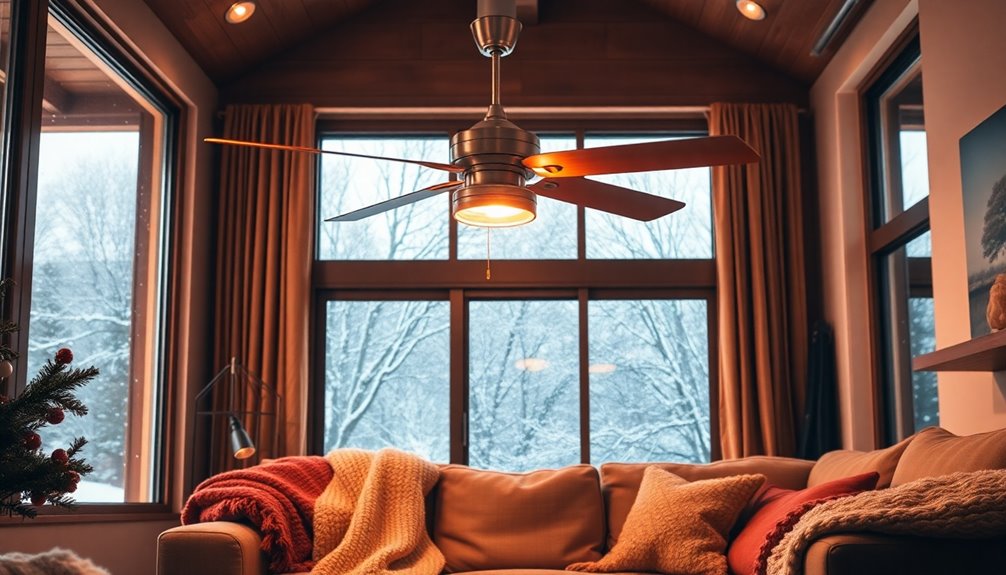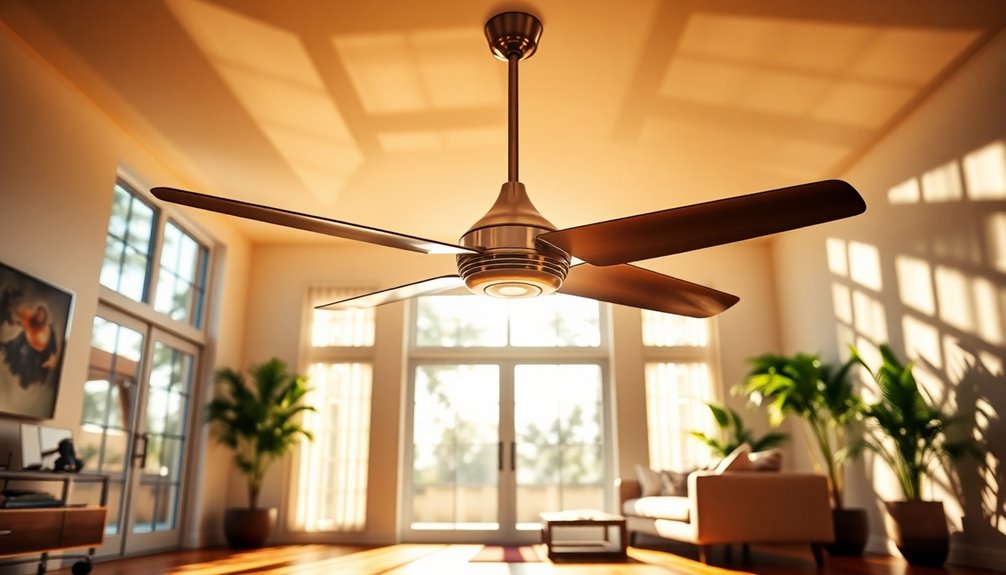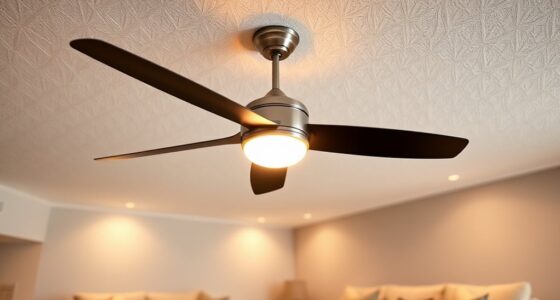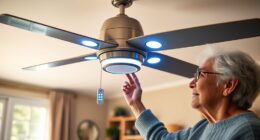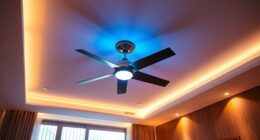To keep your space cozy in winter, set your ceiling fan to rotate clockwise. This direction creates an updraft that pulls cold air up while pushing warm air down, enhancing heating efficiency. You'll feel warmer without cranking up the thermostat and can lower your heating bill by making your system work smarter. Make sure to run the fan on a low speed to avoid any uncomfortable drafts. Adjusting it becomes an easy reminder when Daylight Saving Time changes. Stick around to discover more effective tips on optimizing your ceiling fan for winter comfort.
Key Takeaways
- Ceiling fans should rotate clockwise in winter to create an updraft, pushing warm air down into the living space.
- Adjust the fan direction during Daylight Savings Time changes, particularly when falling back in the fall.
- Use low-speed operation for ceiling fans in winter to prevent drafts while effectively distributing warm air.
- Proper fan use can lower heating bills by up to 15% by allowing thermostat settings to be reduced.
- Remember that ceiling fans can aid in heating efficiency, not just cooling, when used correctly.
Importance of Ceiling Fan Direction

Understanding the importance of ceiling fan direction can greatly enhance your comfort during the winter months. By setting your ceiling fan to rotate clockwise, you create an updraft that pulls the cold air upward, pushing the warm air trapped near the ceiling down toward the floor. This simple adjustment can notably improve your room's heating efficiency.
When you run your fan at a low speed in this direction, it helps distribute heat evenly throughout the space without causing uncomfortable drafts. This means you can enjoy a cozy atmosphere while maintaining a consistent temperature, preventing those pesky cold spots that often occur in winter.
Moreover, adjusting the ceiling fan direction can lead to energy efficiency benefits. You might save up to 15% on heating bills by allowing your thermostat to be set lower while still feeling warm.
The reversing switch on most ceiling fans makes this change easy, ensuring you can switch from counterclockwise in summer to clockwise in winter effortlessly. Embracing the right ceiling fan direction not only enhances your comfort but also supports your energy-saving efforts during the colder months.
Recommended Direction for Winter

To maximize warmth and comfort during winter, you should set your ceiling fan to rotate clockwise. This ceiling fan direction creates an updraft that pulls cold air up while pushing the warm air trapped near the ceiling down towards the floor.
By running the fan at a low speed in this direction, you can evenly distribute warm air throughout the room without causing uncomfortable drafts.
If you haven't already, check for the reversing switch, typically located near the fan base, which makes it easy to change the direction of your fan for the season. Standing directly beneath the fan, you should confirm the clockwise movement to verify effective warm air circulation in your space.
Changing the ceiling fan direction to clockwise not only helps maintain a cozy atmosphere but can also reduce heating costs by up to 10%.
This allows you to set your thermostat at lower temperatures while still staying comfortable. Embrace this simple adjustment this winter, and enjoy the benefits of a more efficiently heated home!
Benefits of Clockwise Rotation

When you set your ceiling fan to rotate clockwise in winter, you enhance heat distribution throughout your space, making it feel cozier.
This simple adjustment can save you up to 15% on heating bills, allowing you to lower your thermostat without sacrificing comfort.
Plus, running the fan at a low speed keeps the warm air circulating gently, so you won't have to deal with uncomfortable drafts.
Enhanced Heat Distribution
By running your ceiling fan in a clockwise direction during winter, you can markedly enhance heat distribution in your home. This simple adjustment creates a gentle updraft that pulls cold air upwards, allowing warm air trapped near the ceiling to circulate more evenly throughout the room.
Here's how this works:
| Benefit | Description |
|---|---|
| Eliminates Cold Spots | Warm air is pushed down, reducing temperature variations. |
| Enhances Comfort | Consistent warmth keeps your living space cozy. |
| Improves Energy Efficiency | Less energy wasted means fewer resources consumed. |
| Low-Speed Operation | Minimizes drafts while redistributing heat. |
| Cost-Effective | Allows lower thermostat settings without sacrificing comfort. |
With the ceiling fan direction set to clockwise rotation, you effectively push warm air down towards the living space, creating a more uniform temperature, especially in rooms with high or vaulted ceilings. Operating your fan at a low speed helps prevent discomfort from drafts while still benefiting from enhanced efficiency. This means you can enjoy a warm, cozy environment during the colder months without over-relying on your heating system. Additionally, energy-efficient technology in heat pumps can further optimize your home's heating performance.
Energy Cost Savings
Running your ceiling fan in a clockwise direction during winter can lead to notable energy cost savings. By circulating warm air that naturally rises to the ceiling, your heating system doesn't have to work as hard, potentially reducing your heating costs by up to 15%. This means you can enjoy a warmer home while keeping your energy bills in check.
When the ceiling fan spins clockwise at a low speed, it creates a gentle updraft that promotes even heat distribution throughout the room. This method prevents cold spots and optimizes comfort without relying solely on your heating system. Instead of cranking up the thermostat, you can lower it a few degrees, allowing for significant energy savings.
Moreover, ceiling fans consume only about 50 watts of electricity, far less than traditional heating systems. This makes them an incredibly energy-efficient option during the colder months.
Comfort Without Drafts
Using your ceiling fan in a clockwise direction during winter can greatly enhance comfort without creating unpleasant drafts.
When you switch the ceiling fan direction, it creates a gentle updraft that pulls cold air upwards, allowing warm air trapped near the ceiling to circulate evenly throughout the room. This method guarantees that you maintain a cozy atmosphere without the harsh winds associated with more aggressive fan spinning.
By operating the fan at a low speed, you prevent uncomfortable drafts that can disrupt your warmth and comfort during colder months. The clockwise rotation is especially effective in eliminating cold spots, making the space feel inviting regardless of the outdoor chill.
Additionally, this simple adjustment can help you save on heating costs, allowing you to lower your thermostat settings while still enjoying a comfortable environment.
With the fan aiding in heat distribution, you'll feel a more consistent warmth surrounding you.
How to Change Fan Direction

Changing your ceiling fan's direction is a simple yet effective way to enhance comfort during the winter months. By reversing the fan, you can circulate warm air that rises to the ceiling, creating a cozy environment. Here's how to change the fan direction based on your type of ceiling fan:
| Fan Type | How to Change Direction | Key Note |
|---|---|---|
| Pull Chain Fans | Turn off the fan, wait for it to stop, then locate the ceiling fan switch on the body to change the direction. | Make sure it's completely stopped. |
| Remote-Controlled | Turn off the fan, make sure the remote is paired, then press and hold the fan button until you see a blinking light. | Confirm the direction has changed. |
| Smart Fans | Use your mobile app or compatible voice commands to adjust the direction. | No manual adjustments needed. |
After you change the fan direction, turn it back on and check that it operates correctly in the newly set direction. This adjustment will help you maintain a comfortable atmosphere while efficiently distributing warm air throughout your space.
Timing for Direction Adjustment

As winter approaches, it's essential to adjust your ceiling fan's direction to maximize comfort and energy efficiency. An ideal time for this change is during Daylight Savings Time adjustments, particularly when you fall back in the fall.
Setting the ceiling fan direction to rotate clockwise helps create an updraft, redistributing warm air trapped near the ceiling back down into your living space. This simple adjustment can lead to significant energy savings of up to 10%, enabling you to lower your thermostat settings while still feeling cozy.
It's recommended to make this direction change before the onset of cold weather to guarantee maximum efficiency throughout winter. By doing this, you can prevent your heating system from overworking and promote better air circulation in your home. Additionally, understanding how heat pumps operate can further enhance your home's heating efficiency.
Making the adjustment at the start of winter not only enhances comfort but also improves your home's heating. Remember, the right ceiling fan direction can make a noticeable difference in your indoor climate, allowing you to enjoy the season without feeling the chill.
Fan Speed Considerations

Typically, running your ceiling fan at a low speed during winter is the best way to guarantee a comfortable living environment.
Set the fan to rotate clockwise, creating a gentle updraft that redistributes warm air throughout the room without making you feel chilled. This low-speed setting is essential for maintaining a steady temperature, eliminating cold spots, and optimizing energy efficiency.
When warm air rises to the ceiling, a low-speed fan helps push that air back down into your living space.
This method enhances your comfort while avoiding the wind chill effect associated with higher fan speeds. You'll notice a significant difference as the warm air circulates more effectively.
Energy Savings Potential

Using your ceiling fan in a clockwise direction during winter can lead to significant cost savings on your heating bills.
By redistributing warm air and allowing you to lower your thermostat by about 4 degrees, you'll maintain comfort without cranking up the heat.
This simple adjustment not only enhances heat distribution but also optimizes the efficiency of your heating system.
Cost Reduction Strategies
A simple adjustment to your ceiling fan can lead to significant cost savings during the winter months. By changing the ceiling fan direction to clockwise, you can effectively redistribute warm air trapped near the ceiling back down into your living space. This simple switch can reduce heating costs by up to 15%, making it one of the best cost reduction strategies available.
You'll also enjoy energy savings by lowering your thermostat settings by about 4 degrees while still feeling comfortable. Running your ceiling fan at low speed guarantees that warm air circulates without creating a draft, enhancing your heating efficiency. Additionally, using ceiling fans in conjunction with HEPA filters can further improve indoor air quality, contributing to a healthier living environment. This approach aligns with the principles of energy efficiency that heat pumps exemplify.
With ceiling fans averaging between 15 to 90 watts, they offer a remarkably energy-efficient alternative compared to heating systems that can consume up to 3,500 watts.
Properly adjusting your ceiling fan direction according to the season is a straightforward yet effective strategy to lower your utility bills. By implementing this small change, you're not only optimizing your home's heating but also contributing to a more sustainable energy approach.
Embrace this simple solution and watch your energy costs decrease this winter.
Efficient Heat Distribution
Efficient heat distribution is essential for maintaining comfort and lowering energy costs during winter months.
By adjusting your ceiling fan direction to spin clockwise at a low speed, you can create a gentle updraft. This action pulls cold air upward while pushing warm air, which is less dense, down into your living space. As a result, you promote even heat distribution throughout the room.
With warm air often trapped near the ceiling, this simple adjustment can lead to energy savings of up to 15% on your heating bills.
You'll find that you can set your thermostat lower, yet still feel cozy in your home. Furthermore, this method helps eliminate hot and cold spots, ensuring every corner of the room stays warm.
Thermostat Setting Adjustments
Adjusting your thermostat setting can markedly impact your energy bills during the winter months. By lowering your thermostat setting by just 4 degrees while running your ceiling fan in a clockwise direction, you can cut heating costs by up to 15%.
This is because ceiling fans help redistribute warm air that naturally rises and gets trapped at the ceiling, creating a more balanced temperature throughout your space.
When you run your ceiling fan at a low speed, it promotes even heat distribution, reducing cold spots and allowing for more efficient thermostat adjustments.
This means you can comfortably lower your thermostat setting without sacrificing warmth. In fact, households utilizing this method can save around 10% on their heating bills during colder months.
Ceiling Fans in High Ceilings

In homes with high ceilings, managing warm air can be a challenge, but using ceiling fans effectively can make a significant difference. You should change the ceiling fan direction to clockwise during winter. This creates an updraft that pulls the cold air upward while pushing the warm air trapped near the ceiling down into the living space.
Running your ceiling fan on low speed enhances heat distribution, making it easier to maintain a comfortable temperature in larger, open areas. High ceilings can lead to increased energy costs due to warm air accumulating at the top of the room, but utilizing a ceiling fan helps improve heating efficiency. This reduces your reliance on the heating system, leading to energy savings of up to 15% on your heating bills. Additionally, modern Energy Star certified fans can enhance airflow and further improve energy efficiency in your home. Proper sizing of ceiling fans can also contribute to optimal performance in high-ceiling spaces.
For best performance in these spaces, consider using fans with a longer downrod. This guarantees that air circulation effectively reaches all areas of the room, maximizing comfort and efficiency. Additionally, ensuring proper color accuracy in your home environment can further enhance your overall comfort and ambiance.
Common Misconceptions About Fan Use

You might think ceiling fans are just for cooling, but they actually help distribute warm air during winter, too.
Many people don't realize that adjusting the fan's direction can make a big difference in comfort and energy savings.
Plus, using a fan on a low speed can enhance warmth without wasting energy.
Fans Only Cool Spaces
Many homeowners believe ceiling fans only serve to cool spaces, but this is a common misconception. In fact, ceiling fans can be incredibly useful during the winter months. By reversing the ceiling fans direction to spin clockwise, you can effectively distribute warm air trapped near the ceiling. This gentle push of warm air creates a more evenly heated room without the drafts that can make you uncomfortable.
Running your fan at a low speed in this direction optimizes heat distribution while preventing the wind chill effect. This means you can maintain a cozy environment without cranking up your thermostat.
Regarding heating cost savings, you could see reductions of up to 15% on your energy bills just by utilizing your ceiling fan wisely.
Many people underestimate the impact of ceiling fans on energy efficiency. They consume only about 50 watts, a fraction of what heating systems use. Additionally, using efficient heating methods like ceiling fans can help mitigate some of the environmental consequences associated with traditional heating methods.
No Direction Adjustments Needed
Ceiling fans often get overlooked when it comes to winter heating, with some homeowners assuming they don't need any adjustments for the colder months. This is a common misconception. In fact, changing the fan direction in winter to a clockwise rotation can greatly improve warm air distribution throughout your space.
| Fan Direction | Effect on Heating |
|---|---|
| Counterclockwise | Creates a chill effect, pushing cool air down |
| Clockwise | Pulls cold air up, forcing warm air down to the living area |
| No Adjustment | Warm air stagnates near the ceiling, leading to uneven heating |
| Adjusted Regularly | Maximizes energy efficiency and comfort in your home |
| Seasonal Change | Reduces heating bills by up to 15% |
Ceiling Fans Waste Energy
How much energy do you think ceiling fans waste during winter due to common misconceptions? Many homeowners believe ceiling fans are just for cooling, but that's not entirely true.
In fact, using your fan correctly can actually save you money on heating costs!
Here are three key points to evaluate:
- Ceiling Fan Direction: In winter, set your ceiling fan to run clockwise at a low speed. This creates a gentle updraft, pushing warm air down from the ceiling and redistributing it throughout the room.
- Energy-Efficient Option: Ceiling fans consume about 50 watts of energy, considerably less than the 3,500 watts used by typical heating systems. This makes fans an energy-efficient choice for maintaining warmth.
- Reducing Heating Costs: By running your ceiling fan in the correct direction, you could save up to 15% on your heating bills. It's a simple adjustment that can lead to substantial savings.
Don't let misconceptions lead to wasted energy. Embrace the benefits of ceiling fans during winter to enhance your comfort and efficiency.
General Tips for Ceiling Fans

When it comes to maximizing the efficiency of your ceiling fan, knowing the right direction to rotate the blades is crucial.
In winter, you should set your fan direction to clockwise rotation. This creates an updraft that pulls cold air upwards while pushing warm air down towards the floor, helping to keep your space cozy. Running your fan at a low speed during these months is key; it helps distribute heat evenly without causing uncomfortable drafts.
Many ceiling fans come equipped with a reversing switch located near the fan base, making it easy to change the direction for seasonal adjustments. By properly utilizing this feature, you can reduce heating costs by up to 10%.
Frequently Asked Questions
How Do You Tell if Your Ceiling Fan Is Going Clockwise or Counterclockwise?
To tell if your ceiling fan's going clockwise or counterclockwise, stand directly underneath it and watch the blades. If they move from the right to the left, it's spinning clockwise.
You can also check the reversing switch on the fan's body to confirm its direction.
Another trick is to place a lightweight paper or feather underneath; if it rises, the fan's creating an updraft, indicating it's rotating clockwise.
What Direction Do I Rub My Ceiling Fan in the Winter?
You should set your ceiling fan to rotate clockwise in the winter.
This direction helps circulate warm air by creating an updraft that pulls cold air up and pushes warm air down towards the floor.
To guarantee it's working properly, stand under the fan and check for a gentle breeze.
This simple adjustment not only keeps your space cozy but can also help reduce your heating costs.
Just flip the reversing switch to change directions!
What Is the Best Ceiling Fan Setting for Winter?
The best ceiling fan setting for winter is to run it at a low speed while rotating clockwise.
This creates an updraft that pushes warm air down, helping to evenly distribute heat throughout the room.
You'll notice more comfort without chilly drafts, and it can even lower your heating costs.
Just flip the reversing switch near the fan base to change the direction easily.
Enjoy a cozier space while saving energy!
Does Reversing the Fan in Winter Really Help?
Does reversing your ceiling fan in winter really help? Absolutely!
By switching the fan's direction, you create a gentle updraft that pushes warm air down, maintaining a cozy atmosphere in your space.
You'll notice a more consistent room temperature without cranking up the thermostat. Plus, running it at low speed prevents any uncomfortable drafts.
With just a simple flip of the switch, you can enhance your comfort and potentially save on heating costs.
Conclusion
As winter wraps the world in a soft, white blanket, don't forget to set your ceiling fan to spin clockwise. This simple adjustment sends warm air swirling down, creating a cozy embrace in your home. Imagine snuggling up with a hot drink, feeling the gentle warmth envelop you, all while saving on energy bills. By making this small change, you'll turn your winter sanctuary into a haven of comfort, ensuring every chilly evening feels like a warm hug.
